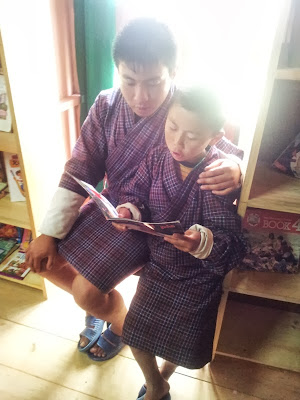As I've compiled these photos, some seem like they are from long ago - much longer than from just this month. I wonder why that is? August has been a very busy month, and intense in some ways. I've been working really hard five and a half days a week at school, and unlike most months of the year, August is known for having no public holidays and we've had no local tsechus to attend.
Meanwhile the Monsoon Football Tournament has been on which has meant Chumey has been a busy place in the afternoons as people from the region flock to watch the games. For me though, I have found it distressing to see that in many cases education has taken a back seat while the preparations for the football take precendence. I've learnt a lot about myself in this time - what I can and can't tolerate, that I am willing to put myself on the line to try to make improvements, and that it can be lonely when you are a lone voice of dissent. It has been surprising that this late in the year when you would think we'd settled into life here, that big challenges are still arising. The life of an expatriate walking the fine line of accepting local culture and ways while staying true to yourself and your own values is not always easy.
With seven months down and less than four months remaining we can't help but start counting down til we return home. Xavier found a Countdown to Christmas app on my phone and facebook which keeps us up to date. By Christmas we'll be sunning ourselves in Penang, Malaysia. Meanwhile though, there are so many exciting things coming up before then that I feel very positive about our remaining time in Bhutan - lots of visitors coming our way very soon, four local Tsechus to enjoy and a couple of other surprises in store that I'm looking forward to share.
So here are the FMS photos of August:
Meanwhile the Monsoon Football Tournament has been on which has meant Chumey has been a busy place in the afternoons as people from the region flock to watch the games. For me though, I have found it distressing to see that in many cases education has taken a back seat while the preparations for the football take precendence. I've learnt a lot about myself in this time - what I can and can't tolerate, that I am willing to put myself on the line to try to make improvements, and that it can be lonely when you are a lone voice of dissent. It has been surprising that this late in the year when you would think we'd settled into life here, that big challenges are still arising. The life of an expatriate walking the fine line of accepting local culture and ways while staying true to yourself and your own values is not always easy.
With seven months down and less than four months remaining we can't help but start counting down til we return home. Xavier found a Countdown to Christmas app on my phone and facebook which keeps us up to date. By Christmas we'll be sunning ourselves in Penang, Malaysia. Meanwhile though, there are so many exciting things coming up before then that I feel very positive about our remaining time in Bhutan - lots of visitors coming our way very soon, four local Tsechus to enjoy and a couple of other surprises in store that I'm looking forward to share.
So here are the FMS photos of August:
 |
| 1 - N is for Noodles! I found this a challenging prompt! 2- Incomplete The house being built next door is incomplete. |
 |
| 30 - Cluttered Our general shop with cluttered with all sorts of things to buy. |
 |
| 31 - Dangerous This massive wasp/bee hive has attached to our eaves and is swarming with insects. I fear that one day I'll walk underneath and it will drop on my head! |
All I can say at the end of this month is bring on September! I'm looking forward to my little daily photo challenge that keeps me present to all the interesting and good things that happen day by day.










































































